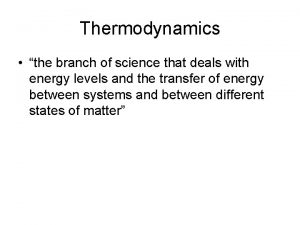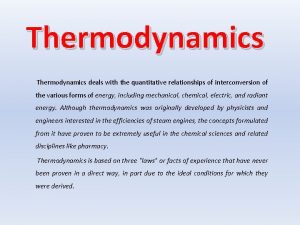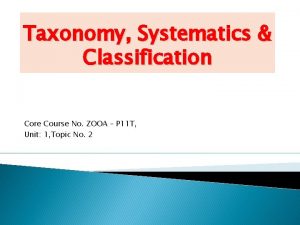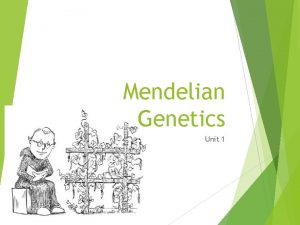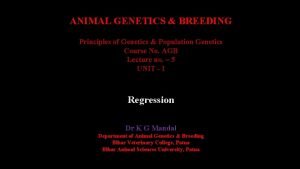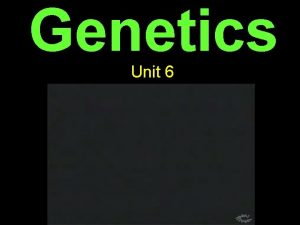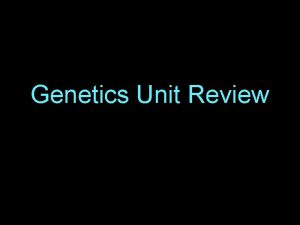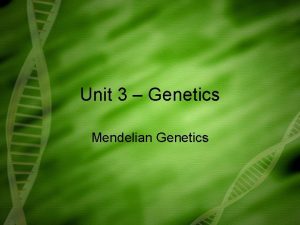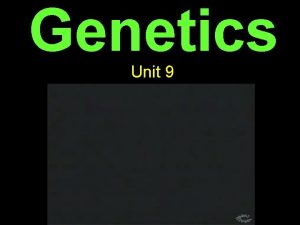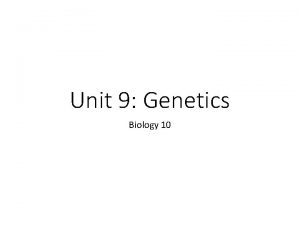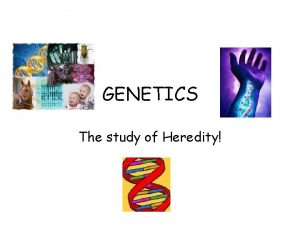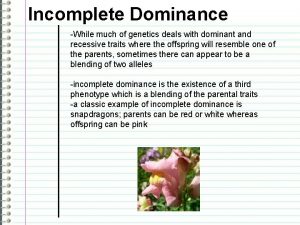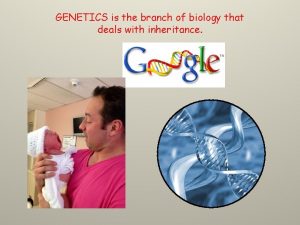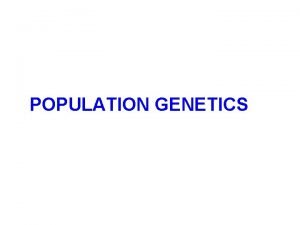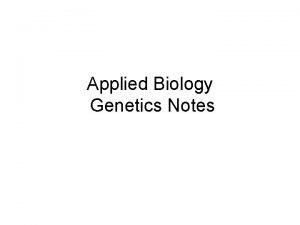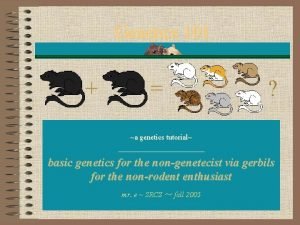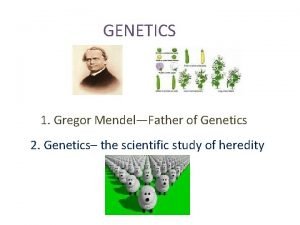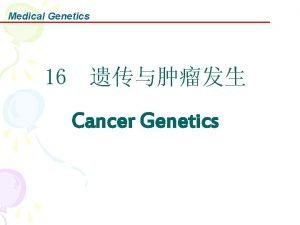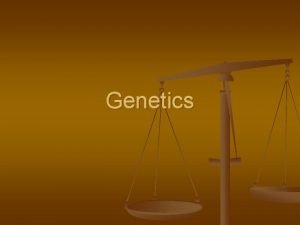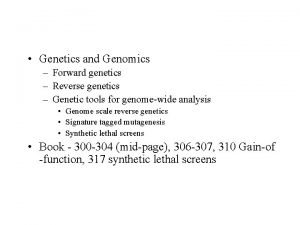Unit 3 Genetics Genetics Deals with the principles
















































- Slides: 48

Unit 3 - Genetics


• Genetics – Deals with the principles of variation and inheritance • Heredity – the passing of genetic characteristics from one generation to the next (ex: Hair/eye colour)

Traits – distinguishing characteristics which makes individuals unique

• Gene – a specific part of DNA, that makes a certain trait (ex: eye color). • Allele – two alleles makes one gene. You get one allele from your mom and one from your dad.


• Mendel studied seven pairs of contrasting traits as follows: Crash Course Biology Video - Heredity https: //www. youtube. com/watch? v=CBezq 1 f. FUEA

• P generation – the parent generation • F 1 generation – the first filial generation; offspring from a cross of the P generation • F 2 generation - the second filial generation; offspring from a cross of the F 1 generation


• Dominant – this allele is always expressed. We use a capital letter to write a dominant allele. • Recessive – this allele is hidden, unless there is no dominant allele present. We use a lowercase letter to write a recessive allele.

Video: Are Your Traits Dominant? https: //www. youtube. com/watch? v=mn. Skz 8 s-b 44

• Heterozygous – two different alleles. One is dominant and the other is recessive. Ex: Aa • Homozygous – two alleles that are identical. Either two dominant alleles or two recessive alleles. Ex: AA or aa


• Purebred – descended from ancestors of a distinct type or breed. All purebreds share similar traits.

• Hybrid – an organism heterozygous for a trait. Ex: Aa Lion + Tiger = Liger

• Phenotype – the physical traits of an organism Ex: the color of your eyes https: //www. 23 andme. com/enca/gen 101/phenotype/

• Genotype – the genetic make-up of an organism. Indicated by letters in a Punnett square. Ex: AA Aa aa

• Punnett Square – a grid used to show all combinations of gametes inherited from a set of parents

• Monohybrid Cross – a cross of ONE trait

• Dihybrid cross – a cross of TWO traits

• Product Rule - the probability that two or more independent events will occur together is the product of their individual probabilities of occurring alone

Who is Gregor Mendel? • An Austrian Monk • Studied Mathematics and Botany • Pioneer in the study of Genetics and Heredity

Video: How Mendel's pea plants helped us understand genetics https: //www. youtube. com/watch? v=Mehz 7 t. Cxj. SE

Turn to page 4 in Booklet

Mendel’s First Cross (P 1 Cross) • Mendel crossed (P): Pure tall (TT) x pure dwarf (tt) • The result (F 1 ): All offspring were tall (Tt)

• But these were not pure tall, because each parent had a different trait for stem height. Instead, these offspring are referred to as hybrids or hybrid tall. – If there is at least ONE dominant allele, they would have the dominant trait (A capital letter is used to represent dominant. Ex: T – In order to show the recessive trait, you must have TWO recessive alleles. The dominant allele will mask or prevent the expression of the recessive allele. (A lowercase letter is used to represent recessive. Ex: t)

Law of Segregation • After his initial experiment, Mendel allowed the hybrid F 1 plants to self pollinate, producing the second filial generation (F 2 generation) • Observed a 3: 1 ratio of tall: short plants. Why did this happen?

Law of Segregation • Mendel made 4 conclusions: • Each parent in the F 1 generation starts with 2 hereditary factors, one dominant and one recessive • Only one factor from each parent is contributed to the offspring • Each offspring inherits one factor from each parent. If the dominant factor is present, it will be expressed even if the recessive factor is also present • The recessive factor will be expressed if only recessive factors are present

Law of Segregation • Law of Segregation – hereditary traits are determined by pairs of alleles from each parent. These alleles separate during gamete formation, giving each offspring only one allele from each parent.

Law of Segregation

Law of Segregation • What are these “factors” which Mendel described? We know them today as Genes: the part of the chromosome that governs the expression of a particular trait • Each gene can occur in alternate forms called alleles. Remember the principle of dominance: a dominant allele may prevent the expression of the recessive allele.

Law of Segregation • • Mendel’s “factors” are inherited as independent units. They are referred to as unit characters Unit Theory is a term describing Mendel’s “factors” of inheritance (genes), which are inherited as independent units. When two alleles at the same gene locus are identical, the individual is said to be homozygous When two alleles at the same gene locus differ, the individual is said to be heterozygous

Genetics and Probability • Heads or Tails? • In groups of 3 or 4, complete the Probability activity worksheet

Genetics and Probability • Probability – the chance, or likelihood, of a particular outcome • Product Rule – the probability that two or more independent events will occur together is the product of their individual probabilities of occurring alone

Punnett Squares • Punnett squares can be used to predict and compare the genetic variations that will result from a cross.

Punnett Squares • Dominant Alleles are usually represented by an upper case letter (eg. Purple plant (R)) • Recessive Alleles are usually represented by a lower case letter (eg. White plant (r))

Punnett Squares • Homozygous or Heterozygous? – RR – Rr – rr Dominant or Recessive?

Punnett Squares • What is the phenotypic ratio of this cross? • In other words, what is the ratio of purple: white plants? • Phenotype – The appearance of the trait in an organism

Punnett Squares • What is the genotypic ratio of this cross? • In other words, what is the ratio of homozygous dominant : heterozygous : homozygous recessive (RR: Rr: rr)? • Genotype – The genetic make-up of an organism

Punnett Squares • Complete Dominance – a type of inheritance where both heterozygotes and dominant homozygotes share the same phenotype

Determining Genotypes • Test Cross – Crossing an individual of unknown genotype with a homozygous recessive individual. Used to determine if an individual expressing a dominant trait is homozygous or heterozygous • Alaskan Malamute example

Complex Inheritance Patterns • Mendel’s 2 nd Experiment – Does the inheritance of one trait influence the inheritance of a different trait? (eg. Does pea shape influence pea colour? ) – Mendel produced purebred pea plants: Round Yellow plants (RY) and Wrinkled Green plants (ry) – Performed a Dihybrid Cross a cross of two individuals that differ in two traits (pea shape/colour)

Dihybrid Cross

Law of Independent Assortment • The inheritance of alleles for one trait does not affect the inheritance of alleles for another trait • New combinations of alleles that are not present in either parent

Incomplete Dominance • Not all traits are completely dominant or recessive • Incomplete Dominance - The blending of the traits of two different alleles at one gene locus that occurs when neither allele is dominant • Eg. White and Red snapdragons are homozygous; Pink snapdragons are heterozygous

Incomplete Dominance

Co-Dominance • Similar to incomplete dominance there is a third phenotype, no definitive dominant or recessive allele • When both alleles of a gene locus are expressed equally (co-dominate), this type of inheritance is known as Co-Dominance

Co-Dominance
 Gregor mendel’s principles of genetics apply to
Gregor mendel’s principles of genetics apply to Mendel's three laws
Mendel's three laws Gregor mendels principles of genetics apply to
Gregor mendels principles of genetics apply to Unit 6 review questions
Unit 6 review questions Hình ảnh bộ gõ cơ thể búng tay
Hình ảnh bộ gõ cơ thể búng tay Bổ thể
Bổ thể Tỉ lệ cơ thể trẻ em
Tỉ lệ cơ thể trẻ em Gấu đi như thế nào
Gấu đi như thế nào Thang điểm glasgow
Thang điểm glasgow Bài hát chúa yêu trần thế alleluia
Bài hát chúa yêu trần thế alleluia Các môn thể thao bắt đầu bằng từ đua
Các môn thể thao bắt đầu bằng từ đua Thế nào là hệ số cao nhất
Thế nào là hệ số cao nhất Các châu lục và đại dương trên thế giới
Các châu lục và đại dương trên thế giới Công thức tính thế năng
Công thức tính thế năng Trời xanh đây là của chúng ta thể thơ
Trời xanh đây là của chúng ta thể thơ Cách giải mật thư tọa độ
Cách giải mật thư tọa độ 101012 bằng
101012 bằng Phản ứng thế ankan
Phản ứng thế ankan Các châu lục và đại dương trên thế giới
Các châu lục và đại dương trên thế giới Thơ thất ngôn tứ tuyệt đường luật
Thơ thất ngôn tứ tuyệt đường luật Quá trình desamine hóa có thể tạo ra
Quá trình desamine hóa có thể tạo ra Một số thể thơ truyền thống
Một số thể thơ truyền thống Bàn tay mà dây bẩn
Bàn tay mà dây bẩn Vẽ hình chiếu vuông góc của vật thể sau
Vẽ hình chiếu vuông góc của vật thể sau Thế nào là sự mỏi cơ
Thế nào là sự mỏi cơ đặc điểm cơ thể của người tối cổ
đặc điểm cơ thể của người tối cổ Ví dụ về giọng cùng tên
Ví dụ về giọng cùng tên Vẽ hình chiếu đứng bằng cạnh của vật thể
Vẽ hình chiếu đứng bằng cạnh của vật thể Phối cảnh
Phối cảnh Thẻ vin
Thẻ vin đại từ thay thế
đại từ thay thế điện thế nghỉ
điện thế nghỉ Tư thế ngồi viết
Tư thế ngồi viết Diễn thế sinh thái là
Diễn thế sinh thái là Dạng đột biến một nhiễm là
Dạng đột biến một nhiễm là So nguyen to
So nguyen to Tư thế ngồi viết
Tư thế ngồi viết Lời thề hippocrates
Lời thề hippocrates Thiếu nhi thế giới liên hoan
Thiếu nhi thế giới liên hoan ưu thế lai là gì
ưu thế lai là gì Hổ sinh sản vào mùa nào
Hổ sinh sản vào mùa nào Khi nào hổ con có thể sống độc lập
Khi nào hổ con có thể sống độc lập Hệ hô hấp
Hệ hô hấp Từ ngữ thể hiện lòng nhân hậu
Từ ngữ thể hiện lòng nhân hậu Thế nào là mạng điện lắp đặt kiểu nổi
Thế nào là mạng điện lắp đặt kiểu nổi Thermodynamics is the branch of science that deals with
Thermodynamics is the branch of science that deals with Thermodynamics deals with
Thermodynamics deals with Microtaxonomy deals with
Microtaxonomy deals with













































